Moving Mountains
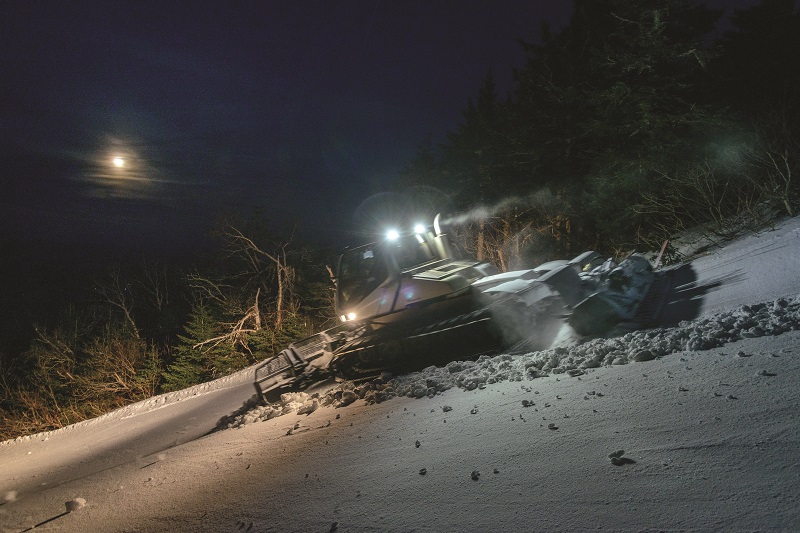
By Lauren Gibbons
Photography By Hubert Schriebl
My family and I have been skiing at Stratton for 18 years. We have seen some great winters and some not-so-great winters, but the quality of snow and trail conditions are routinely pristine. Recently, I had the opportunity to sit down with VP of Mountain Operations Craig Panarisi, Snowmaking Manager Kevin Booth, and Mountain Operations Manager Paul Maitland to discuss the complex task of snowmaking here at Stratton Mountain. I wanted to learn more about how they ensure that consistent snow quality. Craig, Kevin, and Paul were kind enough to answer my questions about the process and strategies they implement, while sharing a few fun facts.
Lauren Gibbons: We got off to a great start this season, thanks to snowmaking. Can you share some of your strategies to get the mountain open and continue to deliver those stellar conditions regardless of the hand Mother Nature deals us?
Kevin Booth: Weather dictates where we go and when we go. We consider skier traffic, lift access, and trail difficulty. Early season, we divide the mountain into priorities so we get as many trails open as quickly as possible. Later in the season, we look for skier feedback to help guide our decisions.
LG: What is the temperature range for snowmaking?
KB: There is a big difference between the temperature that snow can be made and the temperature at which efficient and productive snowmaking can take place. Plus, your thermometer doesn’t tell the entire story. Those temps are ambient; snowmakers consider the wet bulb temps that factor in both ambient temperature and humidity. Humidity plays a major role in determining the temperature at which a water droplet will freeze. Snowmaking becomes more effective and efficient as the air gets colder and drier. Productive snowmaking starts at 28 degrees with 60-percent humidity; single digit to low teens is ideal.
LG: Are wind speed and direction important factors?
KB: Wind direction plays a critical role in our decision-making process. Prevailing winds at Stratton are westerly. For that reason, the majority of our pipelines and snowmaking equipment are on a skier’s left. A west wind will be blowing from behind the gun to disperse the snow on the trail. We do have a few trails designed for making snow during an east wind, which is much less frequent.
LG: How much water is needed to make snow; is there a formula for snowmaking?
Craig Panarisi: There are multiple factors that affect snowmaking, including temperature and humidity, so there isn’t necessarily one main formula. To give you an example of how much water we use, our team can run 10,000 gallons per minute through the system. And it gets recycled back into the streams as it melts in the spring.
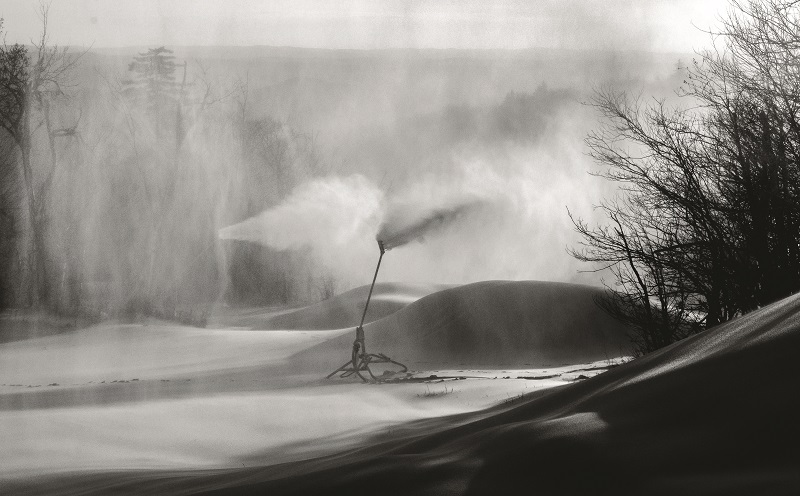
LG: Where does the water for snowmaking come from? Is it alkaline PH-balanced, tap, or bottled?
CP: Our water comes from the local Winhall River and feeds into three different lakes for storage. One lake feeds the next, which feeds the next. It can be a balancing act to keep the lakes replenished and balanced when you’re pumping at capacity. The closest lake at the Stratton Golf Course links to the resort energy center, which is located near the Stratton Mountain Club. From the energy center the water is pumped to any of our 30 or so valve houses located all over the mountain; they divert the water to the individual trails for snowmaking.
LG: I think Mother Nature took a vacation last season but we had great snow coverage all winter here at Stratton. How did you adjust the typical snowmaking process?
CP: Every year is different; our strategies are always changing and evolving. In a tough season like last year, with limited natural snow, we focused on regular resurfacing.
KB: Last season, temperatures fluctuated constantly so we capitalized on very short windows of opportunity. Challenging weather events were more frequent, which forced us to change our strategy. Warmer temperatures gave us an extremely limited amount of time for snowmaking, so we concentrated on surface conditions over building base snow depths.
Paul Maitland: It’s also interesting to note that temperature dictates the amount of air required to make snow. The closer we are to the threshold of not being able to make snow, the more air is required. To simplify that a little, we basically mean the warmer it is the more air we need; the colder it is the more water we need to produce snow.
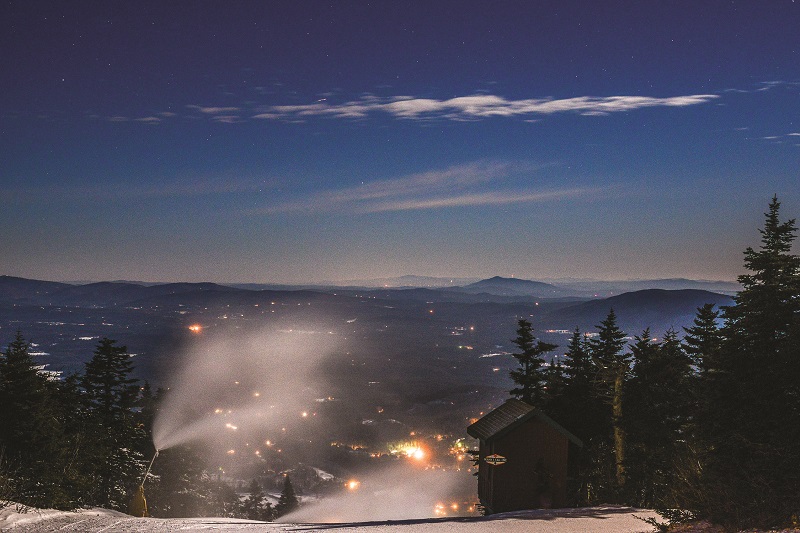
LG: Why do we make snow during the day when the mountain is open?
CP and PM: We make snow when we have an open window, when there is prime temperature and humidity. At Stratton, we run a 24-hour-a-day operation; in order to deliver a quality product, you really can’t afford to let the prime windows pass you by. We get asked why we leave trails open during snowmaking during the day and close others; visibility dictates whether or not the trail is open when we are making snow.
LG: How long does it take to get a trail ready after rain?
KB and CP: How much rain? What time of day did it get cold? What day of the week is it? Are any events coming up? What kind of temperature ranges do we have following the rain? Will we be able to make snow soon? There are a number of different factors to that question!
KB: There are many strategies behind a quick recovery. The grooming team at Stratton is the best at doing this. They have experienced almost every weather scenario and know which tactic works best in each of them.
CP: Every situation is different, but we won’t drive the Snowcats until it hits a certain temperature. They may sit on the mountain until one in the morning, waiting to start until the temperature is right for that night. Sometimes you have to admit that no matter what you do, grooming more, not grooming at all, waiting, not waiting … we’re going to have a rough day in the morning and conditions won’t be as good as they were before the rain! But our team will turn it around quicker than anyone else.
LG: Can you make snow in the glades?
CP: We’ve done some out-of-the-box things, some successful, some we probably won’t try again.
KB: We have done this on occasion for our glade-loving guests. This would normally take place in locations where the glade is very close to existing hydrants and pipelines.
CP: It can be done but it takes skill; snowmaking can pull trees down. But yes, we can. With a little effort we can make snow anywhere on the resort!
“It’s like the Starship Enterprise. Kevin is in command. He runs the whole thing and can control pumps and motors and compressors and water pressure and even water flow … all from one place.”
– Craig Panarisi, VP mountain operations
LG: I heard we have a new computer system for snowmaking; can you tell us about it?
KB: We have installed an updated computer-control system, which is the backbone of the entire snowmaking operation. We need to be able to start, stop, and monitor the running of all our equipment from one location. This program allows us to do this.
CP: It’s like the Starship Enterprise. Kevin is in command. He runs the whole thing and can control pumps and motors and compressors and water pressure and even water flow…all from one place.
LG: I’ve learned that the definition of snowmaking “is the production of snow by forcing water and pressurized air through a ‘snow gun.’” Can you elaborate on the technical aspects and different types of snow guns used?
KB: Snow guns are divided into three types: air-water, low-energy air-water, and fan-gun systems. We use all three to disperse minute water particles and air under pressure into freezing ambient air to make snow. By regulating water content, snow quality can be changed from light powder to a heavier base snow.
PM: To elaborate a little more, all snow guns utilize air and water; a fan gun creates its own air, so it only needs a water line instead of both water and air lines.
Fan guns can be set up on wheels and moved or stationed permanently on a concrete platform, like the large fan gun right outside the Mountain Sports School building in the main base area. One of the great things about fan guns is that the head and nozzle can rotate back and forth to disperse the snow more evenly over a larger area.
Tower guns or low-energy air-water guns are long, tall, narrow guns that are stationed along the trails. Tower guns are connected to both air and water lines. Our resort has roughly 75 miles of air and water lines throughout the mountain. You can think of tower guns as being similar to a sprinkler, but instead they have a longer pole with a nozzle at the very top, and you turn the water and the air on—it’s very much like a spray nozzle. These snow guns are not movable and they’ve been placed in key areas around the resort.
Air-water guns are most effective in warmer temperatures and are the low, noisy guns you might see in a variety of places throughout the resort. They have both air and water lines, but use a lot of air and are very expensive to run. These are our last-case scenario guns, if we can utilize the other guns first to make snow we try to, but again, these are great for warmer temperature days.
CP: Most people refer to those as air-water guns, not sure why, because technically they’re all air and water guns. (All laugh)
LG: Got it; all snow guns run on air and water. Are those the only ingredients needed to make snow?
CP: Our people are the most important ingredient. The combination of cold temperatures and a high-quality snow gun will produce some sort of frozen product. The on-hill snowmaking team is responsible for adjusting that snow gun to produce the quality product for which Stratton is known.
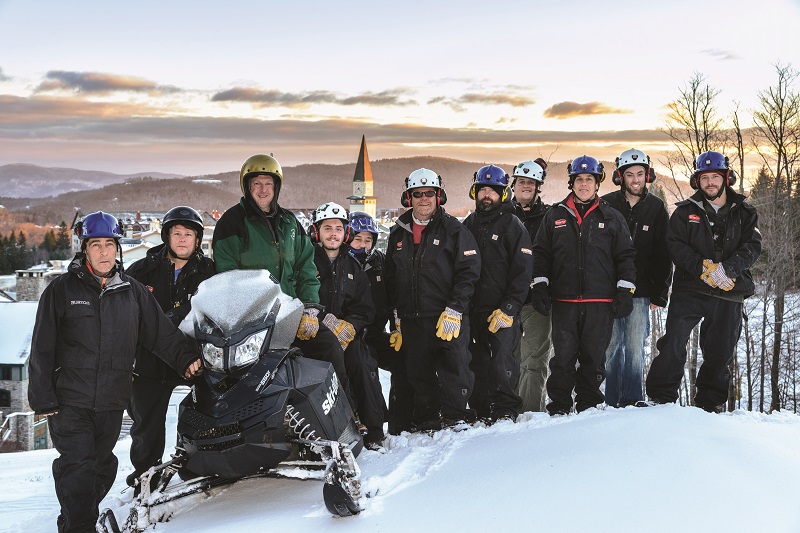
The crew, left to right: Ben Ackert, Craig Collins, Bryan Purcell,
Nate Taylor, Mark Kruszewski, Mark Brescia, Mark Schneski,
Matt Folts, Kevin Booth, J.J. Upton, Rob Smith
LG: About how many people are on your teams?
PM: We have about 20 groomers and up to 30 snowmakers.
LG: What role does grooming play in the snowmaking operation?
KB and CP: We’re all one big team. We depend on each other. When you make snow you don’t want to groom it immediately; the longer the snow sits before you groom it, the better the surface. I am sure you have noticed that our groomers are masters at turning around challenging weather events.
LG: Is it true that driving the groomers is the coolest job in the ski industry?
All: It is a very cool job! These highly skilled operators work all night so that the mountain is corduroy the next day. It is amazing what these skilled operators do on a nightly basis.
LG: What are the hours for groomers?
PM: We have a night crew and a day crew for grooming and snowmaking; our operation is 24 hours. In addition, we have two full-time, dedicated Snowcat mechanics—so our downtime is very minimal.
A rookie will go through two to four weeks of training before he takes a Snowcat out on his own and even then we’re following him and practicing tandem grooming, and we’re on the lower mountain trails with less steep terrain.
LG: How do you communicate with one another? Are there regular morning meetings or night meetings?
PM and CP: We hold operations meetings twice a day, at 7:00am and 1:30pm. These meetings are very specific, brief, and focused. We discuss grooming and snowmaking plans. In the morning, we go over the previous night’s progress and develop a tentative plan for opening; at 1:30 we make plans for the night ahead.
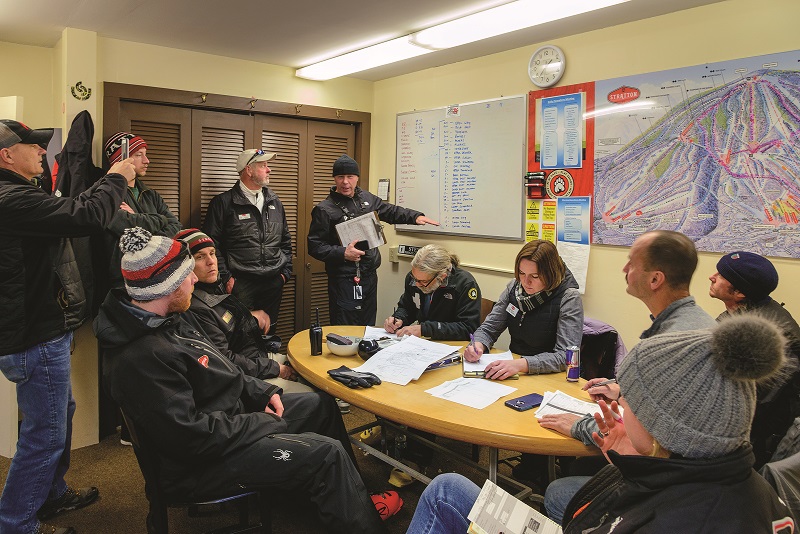
Craig and the mountain operations team at one of their two daily meetings to ensure Stratton’s guests have the best skiing experience possible.
LG: Can you tell us more about the Snowcats and the groomers who operate them?
PM: The average Snowcat spends 1,100 to 1,200 hours per season on the snow. The average price of a new Snowcat is $350,000. We at Stratton are fortunate enough to receive one or two new Snowcats each year. Our groomers typically have had several years of heavy equipment operations experience. We tend to hire a lot of farmers and loggers. Snowcats are fragile equipment. It can also be a secluded job at night, but is truly amazing what the team accomplishes. There’s a lot of training involved for our groomers. For example, a rookie will go through two to four weeks of raining before he takes a Snowcat out on his own and even then we’re following him and practicing tandem grooming, and we’re on the lower mountain trails with less steep terrain.
LG: How many Snowcats does Stratton have?
PM: We have 15 Snowcats total; 11 are frontline machines that are the bread and butter of the team. We also have a Nordic tubing groomer, which is a smaller cat than the frontline fleet. Winch cats are used to move snow to the steep pitches and groom most of the double black-diamond terrain. They have 3,000 feet of cable and can lower themselves down and then pull themselves back up with the winch. We also have utility Snowcats. One of these is designated for the snowmaking team so they can move their tower guns and fan guns. Another utility cat is a transport vehicle that has a cab on the back and can be used for transporting supplies, like food and beverage to mid-mountain. One is for cutting the half pipes or terrain features and lastly, in the summer, we have a cat mower that grinds up all the grass. We mow the mountain once every summer to make the terrain as smooth as possible and to clear the vegetation. This is important for making a solid base layer of snow; it also means we require less snow to make a base than say if we didn’t mow and had two feet of weeds to cover with snow first.
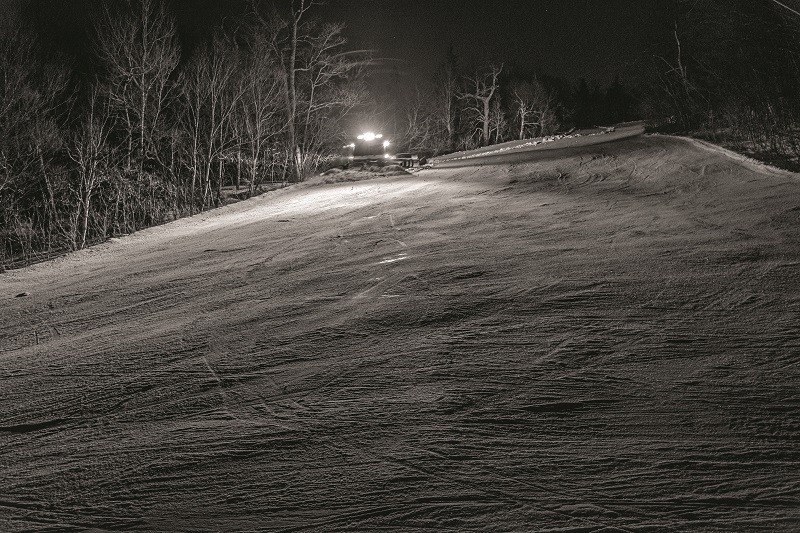
LG: Did we get any new Snowcats this year?
PM: We just received our first hybrid Snowcat. It’s important to point out here this isn’t a typical hybrid like a car—this has a diesel engine and is an EPA mandated, very low emissions engine. All Snowcats run on diesel. A hybrid Tier 4 diesel uses less fuel, is quieter for the operator, and has much cleaner exhaust.
LG: What do you guys do in the offseason? Sunbathe?
PM: Ha! We wish! Summer is dedicated to maintenance and repairs. We mainly focus on the hoses, snow guns, towers, and pipes. The fall is focused on prepping, testing, hiring, training, and staging equipment—like moving the guns, hoses, etc. and strategizing. Maintenance on tower guns occurs at this time. After so many hours of snowmaking, the orifices will wear out so we need to replace the nozzles. Every gun has eight or more nozzles and we have 1,500 tower guns—they’re all 30 feet in the air…it can take a while to tackle all of those.
LG: Any bets on Mother Nature this season? Or trends in annual snowfall that you follow?
CP: All joking aside, it can’t be worse than last year.
KB: In 25 years, that was the second worst year. Odds are good it can only get better from here!
CP: If it doesn’t, our snowmaking capacity will take care of the rest.
LG: One last question. Can you eat the snow?
CP: Well, it comes out of a lake that has fish, frogs, golf balls, people swimming in it, and it goes through many miles of pipe, but other than that…

